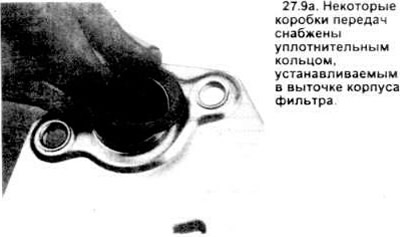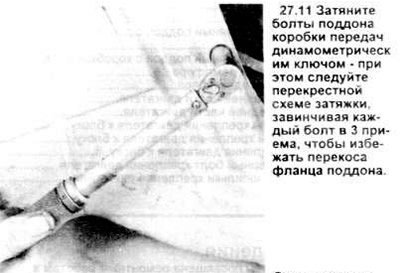Note: the procedure for periodic replacement of fluid and filters is not regulated by the manufacturer. However, if you constantly drive the car or operate it in difficult conditions, then the fluid and filter should be changed regularly.
1. Before starting work, purchase a special fluid for gearboxes (Look "Recommended fluids and lubricants" in chapter 1) and a new filter. Filters are shipped with a new pan gasket and O-ring.
2. The liquid is drained immediately after the car stops. The hot liquid has more sediment and contaminants dissolved in it, which will be removed along with it. Be careful, the temperature of the liquid in the heated box can reach 350 degrees, so wear gloves when draining the liquid.
3. After driving to warm up the transmission fluid, raise the vehicle and place it on jack stands.
4. Place a drain pan under the gearbox. Carefully! Do not touch hot parts of the exhaust system.
5. Remove all pan bolts except for the two rear (see picture). Loosen the two remaining bolts a few turns, but leave them in place to support the pan.

6. Carefully remove the sump from the transmission case and drain the fluid. Try not to spill the liquid when removing the gasket and disconnecting the sump. After the liquid drains, finally unscrew the two bolts and remove the pan.
7. Scrape off the old gasket from the sump and transmission case, then clean the sump with solvent and dry with compressed air. Do not use rags to clean the tray (lint from the rag can contaminate the gearbox).
8. Unscrew the filter bolts or remove the clips and disconnect the filter (see pictures). Discard the filter and o-ring.


9. Attach a new O-ring or clips to the new filter (see drawing), then screw the filter to the transmission case.


10. Flatten the new gasket on the sump, slide the sump under the transmission housing and press the bolts or install the clips.
11. Tighten the pan bolts with a torque wrench in a cross sequence (see picture). Achieve the required tightening torque in three steps.
Caution: do not overtighten the bolts, otherwise the sump flange may be deformed, and this will lead to fluid leakage.

12. Fill transmission with fresh fluid (Look section 7 if necessary).
13. Lower the car, break it in, then recheck the fluid level and possible leaks through the sump.
Visitor comments